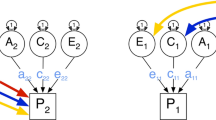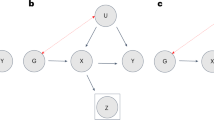Abstract
Because twins and adoptees are a rare resource, they are often studied repeatedly over a period of many years. Differential attrition, and in some studies initial cooperation bias, have the potential to lead to serious biases to estimates of genetic and environmental parameters. Since non-response is often influenced by multiple binary or categorical sociodemographic variables, maximum-likelihood methods are not easily adapted to adjust for such effects. In this brief note we illustrate the use of data-weighting to assess the likely effects of cooperation bias or attrition both on measures of mean or prevalence, and on twin pair correlations or concordances, using data from the Australian twin panel 1981 survey and alcohol challenge studies. Participants in the alcohol challenge study were on average younger, more socially nonconforming, heavier drinkers, more likely to be unmarried, and less likely to report their religion as Other Protestant. Reweighting the alcohol challenge sample to have the same distribution on these variables as the Australian twin panel 1981 survey respondents confirmed that individuals who would feel very intoxicated after a challenge dose of alcohol were underrepresented in the study. However, pairwise data-weighting indicated that this cooperation bias was leading to only a slight underestimation of the importance of genetic effects on subjective intoxication.
Similar content being viewed by others

REFERENCES
Cederlof, R., Epstein, F. H., Friberg, L. T., Hrubec, Z., and Radford, E. P. (1971). Twin registries in the study of chronic disease (with particular reference to the relation of smoking to cardiovascular and pulmonary diseases). Acta Med. Scand. Suppl. 523:1-40.
Eaves, L. J., Eysenck, H. J., and Martin, N. G. (1989). Genes, Culture, and Personality: An Empirical Approach, Academic Press, London.
Efron, B., and Tibshirani, R. (1986). Bootstrap methods for standard errors, confidence intervals, and other measures of statistical accuracy. Stat. Sci. 1:54-77.
Eisen, S. A., True, W., Goldberg, J., Henderson, W., and Robinette, C. D. (1987). The Vietnam Era Twin (VET) Registry: Method of construction. Acta Genet. Med. Gemellol. 36:61-66.
Eysenck, H. J., and Eysenck, S. B. G. (1975). Manual of the Eysenck Personality Questionnaire, Hodder & Stoughton, London.
Heath, A. C., and Martin, N. G. (1990). Psychoticism as a dimension of personality: A multivariate genetic test of Eysenck and Eysenck's psychoticism construct. J. Pers. Soc. Psychol. 58:1-11.
Heath, A. C., and Martin, N. G. (1992). Genetic differences in psychomotor performance decrement after alcohol: A multivariate analysis. J. Stud. Alcohol 53:262-271.
Heath, A. C., Jardine, R., and Martin, N. G. (1989). Interactive effects of genotype and social environment on alcohol consumption in female twins. J. Stud. Alcohol 50:38-48.
Heath, A. C., Bucholz, K. K., Madden, P. A. F., Dinwiddie, S. H., Slutske, W. S., Statham, D. J., Dunne, M. P., Whitfield, J., and Martin, N. G. (1997). Genetic and environmental contributions to alcohol dependence risk in a national twin sample: Consistency of findings in women and men. Psychol. Med. 27:1381-1396.
Holm, N. V., Hauge, M., and Harvald, B. (1980). Etiologic factors of breast cancer elucidated by a study of unselected twins. J. Natl. Cancer Inst. 65(2):285-298.
Hosmer, D. W., and Lemeshow, S. (1989). Applied Logistic Regression, John Wiley & Sons, New York.
Hrubec, Z., and Neel, J. V. (1978). The National Academy of Sciences—National Research Council Twin Registry: Ten years of operation. In Nance, W. E. (ed.), Twin Research, Part B, Biology and Epidemiology, Alan R. Liss, New York, pp. 154-172.
Jardine, R., and Martin, N. G. (1984). Causes of variation in drinking habits in a large twin sample. Acta Genet. Med. Gemellol. 33:435-450.
Kaprio, J., Sarna, S., and Rantasalo, I. (1978). The Finnish Twin Registry: Formation and compilation, questionnaire study, zygosity determination procedures, and research program. Prog. Clin. Biol. Res. 24:179-184.
Kendler, K. S., Neale, M. C., Kessler, R. C., Heath, A. C., and Eaves, L. J. (1992). A population based twin study of major depression in women: The impact of varying definitions of illness. Arch. Gen Psychiatry 49:257-266.
Lee, E. S., Forthofer, R. N., and Lorimor, R. J. (1989). Analyzing Complex Survey Data, Sage, Newbury Park.
Little, R. J. A., and Rubin, D. B. (1987). Statistical Analysis with Missing Data, New York, John Wiley.
Little, R. J. A., and Schenker, N. (1995). Missing data. In Arminger, G., Clogg, C. C., and Sobel, M. E. (eds.), Handbook of Statistical Modeling for the Social and Behavioral Sciences, Plenum, New York, pp. 39-69.
Magnus, P., Berg, K., and Nance, W. E. (1983). Predicting zygosity in Norwegian twin pairs born 1915–1960. Clin. Genet. 24:103-112.
Martin, N. G., and Wilson, S. R. (1982). Bias in the estimation of heritability from truncated samples of twins. Behav. Genet. 12:467-472.
Martin, N. G., Oakeshott, J. G., Gibson, J. B., Starmer, G. A., Perl, J., and Wilks, A. V. (1985a). A twin study of psychomotor and physiological responses to an acute dose of alcohol. Behav. Genet. 15:305-347.
Martin, N. G., Perl, J., Oakeshott, J. G., Gibson, J. B., Starmer, G. A., and Wilks, A. V. (1985b). A twin study of ethanol metabolism. Behav. Genet. 15:93-109.
Medlund, P., Cederlof, R., Floderus-Myrhed, B., and Sorensen, S. (1977). A new Swedish twin registry. Acta Med. Scand. Suppl.600.
Neale, M. C., Eaves, L. J., Kendler, K. S., and Hewitt, J. K. (1989). Bias in correlations from selected samples of relatives: The effects of soft selection. Behav. Genet. 19:163-169.
Neale, M. C., and Eaves, L. J. (1993). Estimating and controlling for the effects of volunteer bias with pairs of relatives. Behav. Genet. 23:271-277.
Neale, M. C. (1998). Mx: Statistical Modeling, Department of Psychiatry, Virginia Commonwealth University.
Rosenbaum, P. R., and Rubin, D. B. (1983). The central role of the proensity score in observational studies for causal effects. Biometrika 70:41-55.
Rubin, D. B. (1987). Multiple Imputation for Nonresponse in Surveys, John Wiley, New York.
SAS Institute (1990) SAS/STAT User's Guide, Version 6, 4th ed., SAS Institute, Cary, NC.
Scarr, S., Webber, P. L., Weinberg, R. A., and Wittig, M. A. (1981). Personality resemblance among adolescents and their parents in biologically related and adoptive families. In Gedda, L., Parisi, P., and Nance, W. E. (eds.), Twin Research 3: Intelligence, Personality, and Development, Alan R. Liss, New York, pp. 99-120.
StataCorp (1997). Stata Statistical Software: Release 5.0, Stata Corporation, College Station, TX.
Author information
Authors and Affiliations
Rights and permissions
About this article
Cite this article
Heath, A.C., Madden, P.A.F. & Martin, N.G. Assessing the Effects of Cooperation Bias and Attrition in Behavioral Genetic Research Using Data-Weighting. Behav Genet 28, 415–427 (1998). https://doi.org/10.1023/A:1021633127604
Issue Date:
DOI: https://doi.org/10.1023/A:1021633127604



